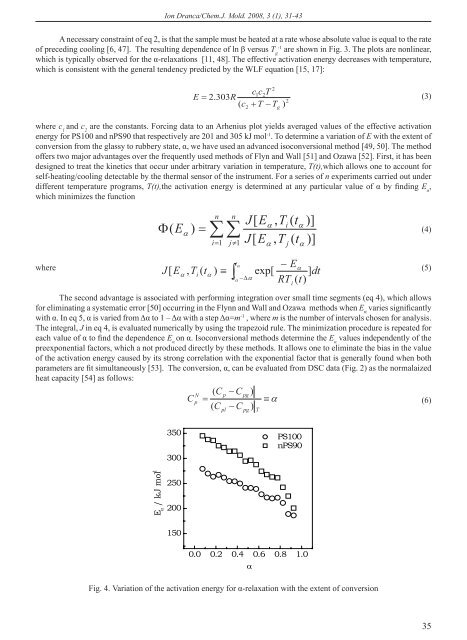chemistry journal of moldova
chemistry journal of moldova
chemistry journal of moldova
Create successful ePaper yourself
Turn your PDF publications into a flip-book with our unique Google optimized e-Paper software.
Ion Dranca/Chem.J. Mold. 2008, 3 (1), 31-43A necessary constraint <strong>of</strong> eq 2, is that the sample must be heated at a rate whose absolute value is equal to the rate<strong>of</strong> preceding cooling [6, 47]. The resulting dependence <strong>of</strong> ln versus T g-1are shown in Fig. 3. The plots are nonlinear,which is typically observed for the -relaxations [11, 48]. The effective activation energy decreases with temperature,which is consistent with the general tendency predicted by the WLF equation [15, 17]:Ec c T2 1 22.303R2( c2 T T g)(3)where c 1and c 2are the constants. Forcing data to an Arhenius plot yields averaged values <strong>of</strong> the effective activationenergy for PS100 and nPS90 that respectively are 201 and 305 kJ mol -1 . To determine a variation <strong>of</strong> E with the extent <strong>of</strong>conversion from the glassy to rubbery state, , we have used an advanced isoconversional method [49, 50]. The method<strong>of</strong>fers two major advantages over the frequently used methods <strong>of</strong> Flyn and Wall [51] and Ozawa [52]. First, it has beendesigned to treat the kinetics that occur under arbitrary variation in temperature, T(t),which allows one to account forself-heating/cooling detectable by the thermal sensor <strong>of</strong> the instrument. For a series <strong>of</strong> n experiments carried out underdifferent temperature programs, T(t),the activation energy is determined at any particular value <strong>of</strong> by finding E ,which minimizes the function(E)n n i i1 j1 J[E, Tj( t)]J[E, T ( t)](4)wheret EJ[ E , Ti ( t ) exp[ ] dttRT ( t)The second advantage is associated with performing integration over small time segments (eq 4), which allowsfor eliminating a systematic error [50] occurring in the Flynn and Wall and Ozawa methods when E varies significantlywith . In eq 5, is varied from to 1 – with a step =m -1 , where m is the number <strong>of</strong> intervals chosen for analysis.The integral, J in eq 4, is evaluated numerically by using the trapezoid rule. The minimization procedure is repeated foreach value <strong>of</strong> to find the dependence E on . Isoconversional methods determine the E values independently <strong>of</strong> thepreexponential factors, which a not produced directly by these methods. It allows one to eliminate the bias in the value<strong>of</strong> the activation energy caused by its strong correlation with the exponential factor that is generally found when bothparameters are fit simultaneously [53]. The conversion, , can be evaluated from DSC data (Fig. 2) as the normalaizedheat capacity [54] as follows:( Cp Cpg)NCp (6)( C C )plpgTi(5)350300PS100nPS90E / kJ mol -12502001500.0 0.2 0.4 0.6 0.8 1.0Fig. 4. Variation <strong>of</strong> the activation energy for -relaxation with the extent <strong>of</strong> conversion35
















